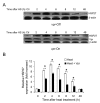Anti-vpr activities of heat shock protein 27
- PMID: 17622316
- PMCID: PMC1906686
- DOI: 10.2119/2007–00004.Liang
Anti-vpr activities of heat shock protein 27
Abstract
HIV-1 Vpr plays a pivotal role in viral pathogenesis and is preferentially targeted by the host immune system. In this report, we demonstrate that a small heat shock protein, HSP27, exhibits Vpr-specific antiviral activity, as its expression is specifically responsive to vpr gene expression and increased levels of HSP27 inhibit Vpr-induced cell cycle G2 arrest and cell killing. We further show that overexpression of HSP27 reduces viral replication in T-lymphocytes in a Vpr-dependent manner. Mechanistically, Vpr triggers HSP27 expression through heat shock factor (HSF) 1, but inhibits prolonged expression of HSP27 under heat-shock conditions. Together, these data suggest a potential dynamic and antagonistic interaction between HIV-1 Vpr and a host cell HSP27, suggesting that HSP27 may contribute to cellular intrinsic immunity against HIV infection.
Figures






Similar articles
-
Antagonistic interaction of HIV-1 Vpr with Hsf-mediated cellular heat shock response and Hsp16 in fission yeast (Schizosaccharomyces pombe).Retrovirology. 2007 Mar 7;4:16. doi: 10.1186/1742-4690-4-16. Retrovirology. 2007. PMID: 17341318 Free PMC article.
-
Heat-shock proteins reverse the G2 arrest caused by HIV-1 viral protein R.DNA Cell Biol. 2004 Apr;23(4):223-5. doi: 10.1089/104454904773819806. DNA Cell Biol. 2004. PMID: 15142379
-
Anti-Vpr activity of a yeast chaperone protein.J Virol. 2004 Oct;78(20):11016-29. doi: 10.1128/JVI.78.20.11016-11029.2004. J Virol. 2004. PMID: 15452222 Free PMC article.
-
HIV-1 viral protein R (Vpr) and its interactions with host cell.Curr HIV Res. 2009 Mar;7(2):178-83. doi: 10.2174/157016209787581436. Curr HIV Res. 2009. PMID: 19275587 Free PMC article. Review.
-
HIV-1 viral protein R (Vpr) regulates viral replication and cellular proliferation in T cells and monocytoid cells in vitro.J Leukoc Biol. 1997 Jul;62(1):93-9. doi: 10.1002/jlb.62.1.93. J Leukoc Biol. 1997. PMID: 9225999 Review.
Cited by
-
Inhibitors of eicosanoid biosynthesis influencing the transcripts level of sHSP21.4 gene induced by pathogen infections, in Antheraea pernyi.PLoS One. 2015 Apr 6;10(4):e0121296. doi: 10.1371/journal.pone.0121296. eCollection 2015. PLoS One. 2015. PMID: 25844646 Free PMC article.
-
Inhibition of NF-κB activity by HIV-1 Vpr is dependent on Vpr binding protein.J Cell Physiol. 2013 Apr;228(4):781-90. doi: 10.1002/jcp.24226. J Cell Physiol. 2013. PMID: 23001849 Free PMC article.
-
The Role of Molecular Chaperones in Virus Infection and Implications for Understanding and Treating COVID-19.J Clin Med. 2020 Oct 30;9(11):3518. doi: 10.3390/jcm9113518. J Clin Med. 2020. PMID: 33143379 Free PMC article. Review.
-
Diversity in heat shock protein families: functional implications in virus infection with a comprehensive insight of their role in the HIV-1 life cycle.Cell Stress Chaperones. 2021 Sep;26(5):743-768. doi: 10.1007/s12192-021-01223-3. Epub 2021 Jul 27. Cell Stress Chaperones. 2021. PMID: 34318439 Free PMC article. Review.
-
Proteomic analysis reveals virus-specific Hsp25 modulation in cardiac myocytes.J Proteome Res. 2010 May 7;9(5):2460-71. doi: 10.1021/pr901151k. J Proteome Res. 2010. PMID: 20196617 Free PMC article.
References
Publication types
MeSH terms
Substances
Grants and funding
LinkOut - more resources
Full Text Sources
Research Materials
Miscellaneous
